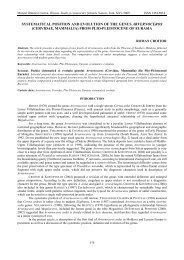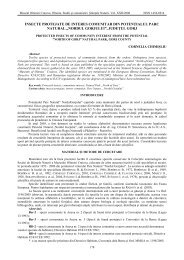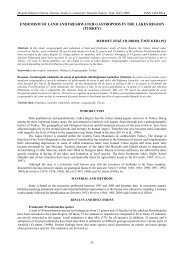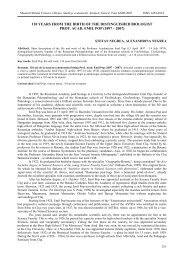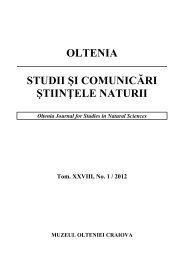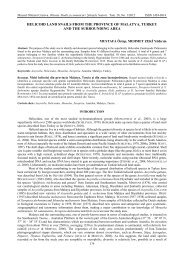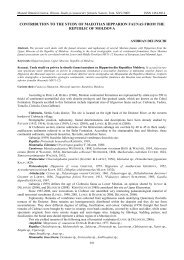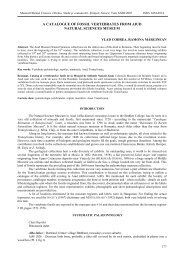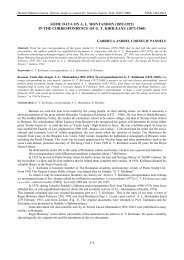Download - Oltenia, Studii si Comunicari, Stiintele Naturii
Download - Oltenia, Studii si Comunicari, Stiintele Naturii
Download - Oltenia, Studii si Comunicari, Stiintele Naturii
You also want an ePaper? Increase the reach of your titles
YUMPU automatically turns print PDFs into web optimized ePapers that Google loves.
CIOBOIU Olivia<br />
The Dacian Province is the largest zoogeographical unit on the territory of our country and includes the entire<br />
mountain region and partially the hilly region. Most of the species living in this province display a Central-European<br />
distribution. The main gastropods characteristic to the province are (GROSSU, 1946; GROSSU & NEGREA, 1984;<br />
FALNIOWSKI et al., 2009): Valvata (V.) cristata O. F. MULLER 1774, Paladilhia (Paladilhiop<strong>si</strong>s) transsylvanica<br />
ROTARIDES 1943, P. (P.) carpathica SOOS 1940, P. (P.) leruthi C. R. BOETGER 1940, Bythinella austriaca<br />
(FRAUENFELD 1857), B. dacica (GROSSU 1946), B. grossui FALNIOWSKI, SZAROWSKA & SÎRBU, 2009; B. molcsany (J.<br />
WAGNER 1941).<br />
The Moes<strong>si</strong>c Province includes the high and low plains, as well as the hilly or even the mountain regions from<br />
Banat, <strong>Oltenia</strong>, Muntenia and North and South Dobroudja. Most of the fauna present in this province is made up of<br />
species that usually live in the plain and hilly regions of the country and are common to all the zoogeographical<br />
provinces (GROSSU, 1955; BOTONEANU & NEGREA, 1976). Aquatic gastropods developed in a <strong>si</strong>gnificant number in<br />
this province. Thus, we mention the species – Theodoxus (Th.) d. stragulatus (C. PFEIFFER 1828), Th. (Th.)<br />
transversalis (C. PFEIFFER 1828), Viviparus viviparus (LINNAEUS 1758), Valvata (Cincinna) piscinalis antiqua MORRIS<br />
1838, Borysthenia naticina (MENKE 1845), Lithoglyphus apertus (KUSTER 1852), L. pygmaeus FRAUENFELD 1863,<br />
Bithynia (Codiella) troschelli (PAASCH 1842), Esperiana (Microcolpia) daudebardii acicularis (FERUSSAC 1823),<br />
Amphimelania holandri (C. PFEIFFER 1828), Physella (Costatella) acuta (DRAPARNAUD 1805), Stagnicola palustris (O.<br />
F. MULLER 1774), Radix ampla (W. HARTMANN 1821), R. labiata (ROSSMASSLER 1835), Galba truncatula (O. F.<br />
MULLER 1774), Ancylus fluviatilis O. F. MULLER 1774, Ferris<strong>si</strong>a (Pettancylus) cles<strong>si</strong>niana (JICKELI 1882),<br />
Biomphalaria tenogophila (ORBIGNY 1835), Anisus (Anisus) leucostoma (MILLET 1813), Anisus (Disculifer) vorticulus<br />
TROSCHEL 1852, Gyraulus (Gyraulus) albus (O. F. MULLER 1774), Gyraulus (Lamorbis) rossmaessleri (AUERSWALD<br />
1852), Planorbella duryi (WETHERBY 1879).<br />
Ancylus fluviatilis, a specific reophilic form, was quite often identified on the river rocks in Banat, at the mouth<br />
of the Danube tributaries (BNRESCU & SÎRBU, 2002). Radix ampla and R. labiata, more or less limnophilous species,<br />
appear in the areas with still water, where aquatic vegetation finds appropriate development conditions. In the springs<br />
located on the valleys of the Mraconia and Berzeasca rivers, the species Radix labiata was identified in a biocoeno<strong>si</strong>s<br />
on the sandy bottoms in moss.<br />
In the components of the biocoenoses from permanent or temporary stagnant waters, gastropods make up<br />
relatively dense populations, which develop in almost all the pools located in the Iron Gates area. In this province, there<br />
were also identified the species belonging to the Planorbis and Anisus genus, as well as the species Amphimelania<br />
holandri (NEGREA, 1994).<br />
The Pannonian Province is located in Banat-Crisana Plain, in the west of our country. In terms of age, it is<br />
younger than the Dacian province. From the phy<strong>si</strong>cal-geographical point of view, it covers a flat surface with forest<br />
steppe vegetation (oak forests, Turkish and Hungarian oak alternating with gramineous plants), rivers characterized by a<br />
high discharge and a moderate continental climate (BOTONEANU & NEGREA, 1976; BNRESCU & ARION, 1982;<br />
GROSSU, 1986). The gastropods from this province are represented by the species Theodoxus (Th.) prevostianus (C.<br />
PFEIFFER 1828) and Melanop<strong>si</strong>s parreys<strong>si</strong> PHILIPPI 1847.<br />
The Pontic Province covers the low plain and hilly regions from Brgan, Dobroudja Plateau, and Covurlui<br />
Plain (GROSSU, 1939; CIOBOIU, 2003). In this province, there were identified the most numerous aquatic gastropod<br />
species from Romania – Theodoxus (Th.) euxinus (CLESSIN 1887), Th. (Th.) fluviatilis (LINNAEUS 1758), Th. (Th.)<br />
palla<strong>si</strong> LINDHOLM 1924, Viviparus contectus (MILLET 1813) (Ponto-Dacian species), Pseudamnicola (P.) dobrogica<br />
GROSSU 1986, P. (P.) leontina GROSSU 1986, P. (P.) penchinati (BOURGUIGNAT 1870), P. (P.) razelmiana GROSSU<br />
1986, P. (P.) bacescui GROSSU 1986, Grossuana codreanui GROSSU 1946, Bythinella a. melanostroma BRANCSIK<br />
1889, Potamopyrgus jenkin<strong>si</strong> (SMITH 1889), Turricaspia (Cles<strong>si</strong>niola) variabilis (EICHWALD 1838), T. (Laevicaspia)<br />
lincta (MILASCHEWITCH 1908), T. (Oxypyrgula) ismailen<strong>si</strong>s (GOL. & STAROB. 1966), T. (Turricaspia) dimidiata<br />
(EICHWALD 1841), T. (Micromelania) ostroumovi (GOL. & STAROB. 1966), Esperiana esperi (A. FERUSSAC 1823),<br />
Hippeutis complanatus (LINNAEUS 1758), Oxyloma (O.) dunkeri (L. PFEIFFER 1865), O. (O.) elegans (RISSO 1826), O.<br />
(O.) pinteri GROSSU 1987.<br />
The Moldavian Province (Sarmatic) presents a fauna characteristic to forest steppe regions (GROSSU, 1987).<br />
Among gastropods, we mention Anisus (A.) calculiformis (SANDBERGER 1874).<br />
The endemic species hold a great share in the total number of gastropods. Even if there spreading area is<br />
limited, there are rich populations (GROSSU, 1993; Fauna Europaea, 2005). These are elements that originate in<br />
Romania and so far they have been identified only in our country, the deci<strong>si</strong>ve role being played by the Danube<br />
hydrographic ba<strong>si</strong>n. Among these species, we mention:<br />
endemic species within the Pontic Province: Theodoxus (Th.) euxinus (CLESSIN 1887), Th. (Th.) palla<strong>si</strong><br />
LINDHOLM 1924 (ponto-caspic), Pseudamnicola (P.) dobrogica GROSSU 1986, P. (P.) leontina GROSSU 1986, P. (P.)<br />
penchinati (BOURGUIGNAT 1870), P. (P.) razelmiana GROSSU 1986, P. (P.) bacescui GROSSU 1986, Grossuana<br />
codreanui GROSSU 1946, Turricaspia (Laevicaspia) lincta (MILASCHEWITCH 1908), T. (Oxypyrgula) ismailen<strong>si</strong>s (GOL.<br />
& STAROB. 1966), T. (Turricaspia) dimidiata (EICHWALD 1841);<br />
Ponto-Danubian endemic species: Theodoxus (Th.) danubialis (C. PFEIFFER 1828), Th. (Th.) transversalis<br />
(C. PFEIFFER 1828), Borysthenia naticina (MENKE 1845) (Ponto-Danubian-Baltic species), Viviparus viviparus<br />
(LINNAEUS 1758), Lithoglyphus naticoides (C. PFEIFFER 1828) (endemic species in the Danube ba<strong>si</strong>n), L. apertus<br />
168



